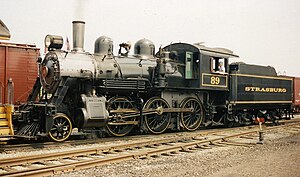2-6-0

Front of locomotive at left
|
|||||||||||||

Canadian National E-10-a class no. 89
|
|||||||||||||
|
|||||||||||||
|
|||||||||||||
|
|||||||||||||
|
|||||||||||||
| Equivalent classifications | |
|---|---|
| UIC class | 1C |
| French class | 130 |
| Turkish class | 34 |
| Swiss class | 3/4 |
| Russian class | 1-3-0 |
| First known tank engine version | |
|---|---|
| First use | c. 1870 |
| Country | United Kingdom |
| Railway | Garstang and Knot-End Railway |
| First known tender engine version | |
|---|---|
| First use | 1852-53 |
| Country | United States of America |
| Locomotive | Pawnee |
| Railway | Philadelphia and Reading Rail Road |
| Builder |
Baldwin Locomotive Works Norris Locomotive Works |
| First known "True type" version | |
|---|---|
| First use | 1860 |
| Country | United States of America |
| Railway | Louisville and Nashville Railroad |
| Evolved from | 2-4-0 |
Under the Whyte notation for the classification of steam locomotives, 2-6-0 represents the wheel arrangement of two leading wheels on one axle, usually in a leading truck, six powered and coupled driving wheels on three axles and no trailing wheels. This arrangement is commonly called a Mogul.
In the United States of America (USA) and Europe, the 2-6-0 wheel arrangement was principally used on tender locomotives. This type of locomotive was widely built in the USA from the early 1860s to the 1920s.
Although examples were built as early as 1852–53 by two Philadelphia manufacturers, Baldwin Locomotive Works and Norris Locomotive Works, these first examples had their leading axles mounted directly and rigidly on the frame of the locomotive rather than on a separate truck or bogie. On these early 2-6-0 locomotives, the leading axle was merely used to distribute the weight of the locomotive over a larger number of wheels. It was therefore essentially an 0-8-0 with an unpowered leading axle and the leading wheels did not serve the same purpose as, for example, the leading trucks of the 4-4-0 American or 4-6-0 Ten-Wheeler types which, at the time, had been in use for at least a decade.
The first American 2-6-0 with a rigidly mounted leading axle was the Pawnee, built for heavy freight service on the Philadelphia and Reading Rail Road. In total, about thirty locomotives of this type were built for various American railroads. While they were generally successful in slow, heavy freight service, the railroads that used these first 2-6-0 locomotives didn't see any great advantages in them over the 0-6-0 or 0-8-0 designs of the time. The railroads noted their increased pulling power, but also found that their rather rigid suspension made them more prone to derailments than the 4-4-0 locomotives of the day. Many railroad mechanics attributed these derailments to having too little weight on the leading truck.
...
Wikipedia
